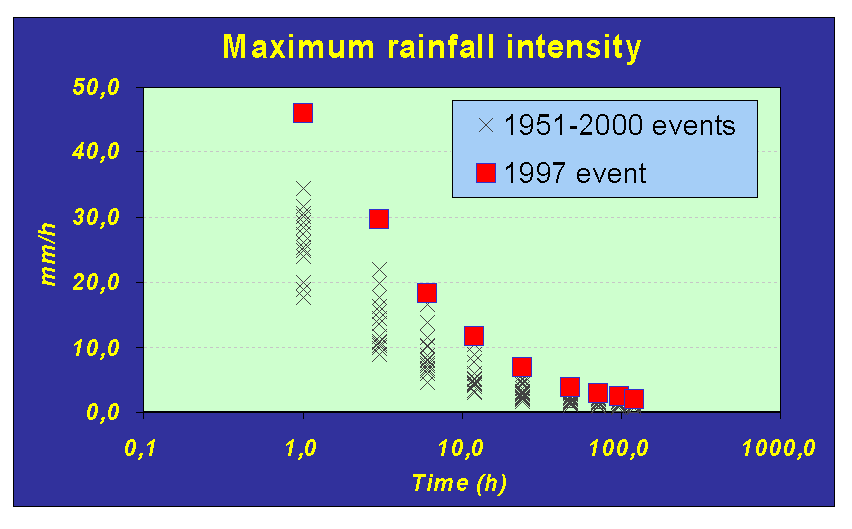June
27-28, 1997 rainfall Event
A
short-duration high-intensity rainfall event interested the basin of Esino
river on June 27-28th 1997. In less than 2 hours almost 100 mm of
rain felt within the study area, triggering many landslides. Rain gauges
data and radar images have been used to describe the rainfall event. Rain
gauges with hourly records are located in Bellano (202 m a.s.l.), on the
north-east edge of the study area and Barzio (755 m a.s.l.), 8 km to the
east. Radar data for Mount Lema radar station, 35 km to the west of the
study area, were provided by the Swiss Meteorological Institute. Rainfall
intensities (R) are estimated from the measured radar reflectivity (Z) with
a Z-R relationship, with time interval between measurements of 5 minutes,
and with a spatial resolution of 2 x 2 km. In order to correct those factors
that affect the accuracy of the estimation, the Swiss Meteorological
Institute performs an automatic calibration of the instruments to verify the
stability of all important components, a software processing in order to
partially eliminate ground clutter, shadowing by mountain ridges and a
long-term correlation and adjustment with data from rain gauges (Joss et al.,
1997).
Radar
estimated intensities are classified in 5 classes, making more complicate
the comparison with rain-gauges data. Figure 4 shows a comparison of the two
sets of intensities for the rainfall event at the stations of Bellano and
Barzio. Rain gauge data satisfactory fit the range of values given by radar
data, and approximately follow the calculated mean value of radar intensity.
This is especially true for the Bellano rain-gauge station. This result
supports the use of radar derived rainfall intensities for application in
landslide triggering assessment, at least in this special case.

Figure
4. Hourly rainfall data from 2:00 a.m. of the 27th to 6:00 a.m.
of 28th June 1997 from Bellano and Barzio rain gauges. 30 minutes
radar data from Mount Lema station have been hourly averaged to compare with
rain gauge data.

Figure
5. 30 minutes radar sketches of the rainfall event, from 0:30 a.m. to 3.00
a.m. of 28th June 1997.
The
high intensity-short duration rainstorm hit the study area in the night
between 27th and 28th June 1997. The thunderstorm
reached the southern part of the study area at 1:00 a.m., moving northerly
(figure 5). From 01:30 to 02:30 the rainstorm passed through Bellano, as the
rain gauge station correctly recorded with measured intensity of 39 mm/h
between 1:00 and 2:00 a.m., and 46 mm/h between 2:00 and 3:00 a.m. (figure
6a). Prolonged low-intensity precipitation characterised the 2 preceding
months, with almost 280 mm of rain (figure 6b). Then, even if the days
immediately antecedent the event were characterised by moderate rainfalls
(50 mm of rain in one week), the initial soil moisture should have been high
at the beginning of the high intensity rainstorm.

Figure
6. a) Hourly rainfall intensity and cumulated rainfall from Bellano rain
gauge; b daily rainfall data from Bellano rain gauge station from the 1st
January to 31st August 1997; the 27th - 28th
rainfall event followed a 2-months period of prolonged low intensity
precipitation.

Figure
7. Recurrence time of rainfall events at Bellano rain gauge compared with
the 27th - 28th June 1997 even
The
statistical analysis of historical rainfall data indicates that the event
was exceptional if compared with the last 50 years of precipitation,
especially for short time duration events. The calculated recurrence time
ranges from 75 years for the short time (1 to 2 hours) to 25 years a longer
duration time (1 to 23 days) (figure 7).





